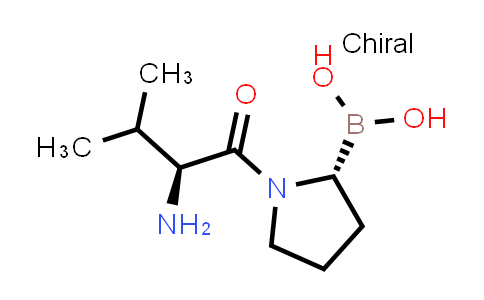| Chemical Name |
Talabostat |
| CAS Number |
149682-77-9 |
| MDL Number |
MFCD09833674 |
| Molecular Formula |
C9H19BN2O3 |
| Molecular Weight |
214.07 |
| Synonyms |
Val-boroPro;PT100 |
Introduction of 149682-77-9 :
Talabostat (Val-boroPro; PT100) is an orally active and nonselective dipeptidyl peptidase IV (DPP-IV) inhibitor (IC50 < 4 nM; Ki = 0.18 nM) and the first clinical inhibitor of fibroblast activation protein (FAP) (IC50 = 560 nM), inhibits DPP8/9 (IC50 = 4/11 nM; Ki = 1.5/0.76 nM), quiescent cell proline dipeptidase (QPP) (IC50 = 310 nM), DPP2, and some other DASH family enzymes. Antineoplastic and hematopoiesis- stimulating activities[1][2][3]. IC50 & Target: IC50: < 4 nM (DPP-IV), 4/11 nM (DPP8/9), 310 nM (QPP), 560 nM (FAP)[1]
Ki: 0.18 nM (DPP-IV), 1.5/0.76 nM (DPP8/9)[2] In Vitro: By cleaving N-terminal Xaa-Pro or Xaa-Ala residues, Talabostat (Val-boroPro) inhibits dipeptidyl peptidases, such as FAP, resulting in the stimulation of cytokine and chemokine production and specific T-cell immunity and T-cell dependent activity[3].
Talabostat (Val-boroPro) competitively inhibits the dipeptidyl peptidase (DPP) activity of FAP and CD26/DPP-IV, and there is a high-affinity interaction with the catalytic site[4]. In Vivo: Talabostat (Val-boroPro; PT100) can stimulate immune responses against tumors involving both the innate and adaptive branches of the immune system.
In WEHI 164 fibrosarcoma and EL4 and A20/2J lymphoma models, Talabostat (Val-boroPro) causes regression and rejection of tumors. The antitumor effect appears to involve tumor-specific CTL and protective immunological memory.
Talabostat (Val-boroPro) treatment of WEHI 164-inoculated mice increases mRNA expression of cytokines and chemokines known to promote T-cell priming and chemoattraction of T cells and innate effector cells[4].
| Purity |
NLT 98% |
| Storage |
at 20ºC 2 years |
*The above information is for reference only.
